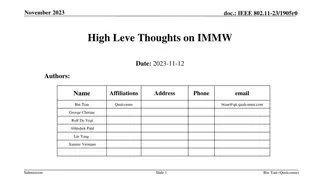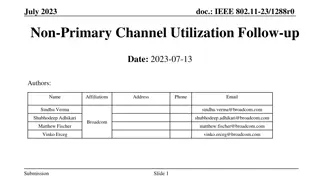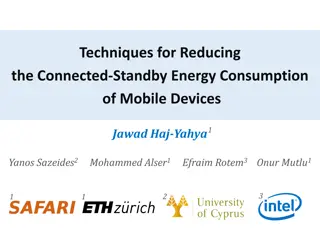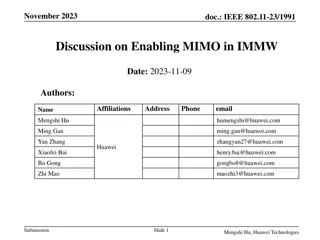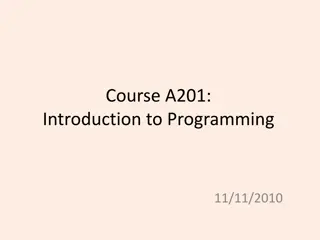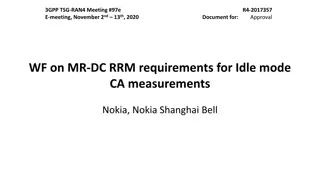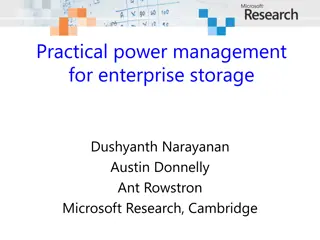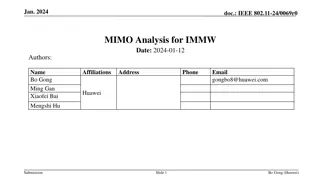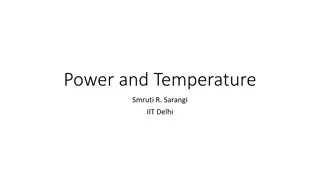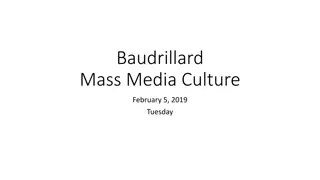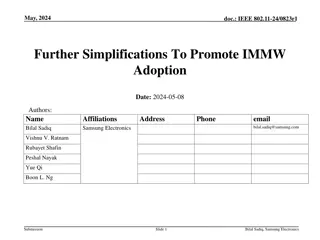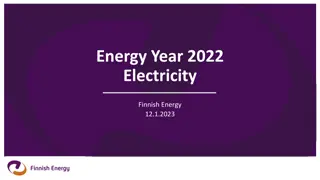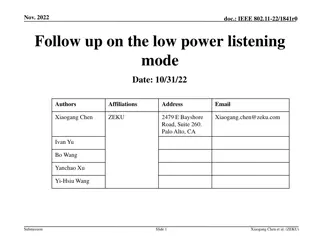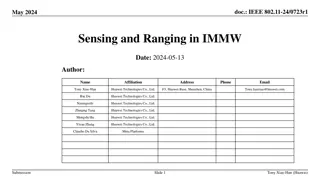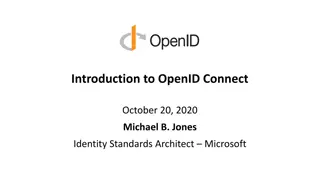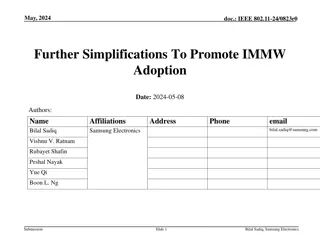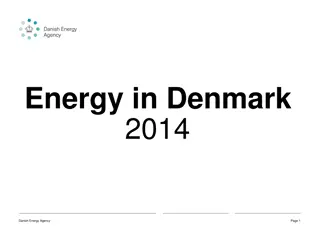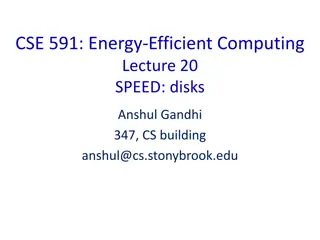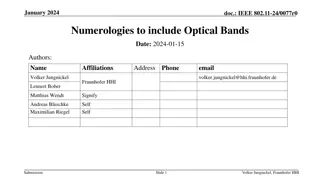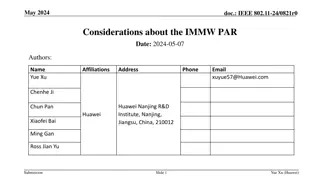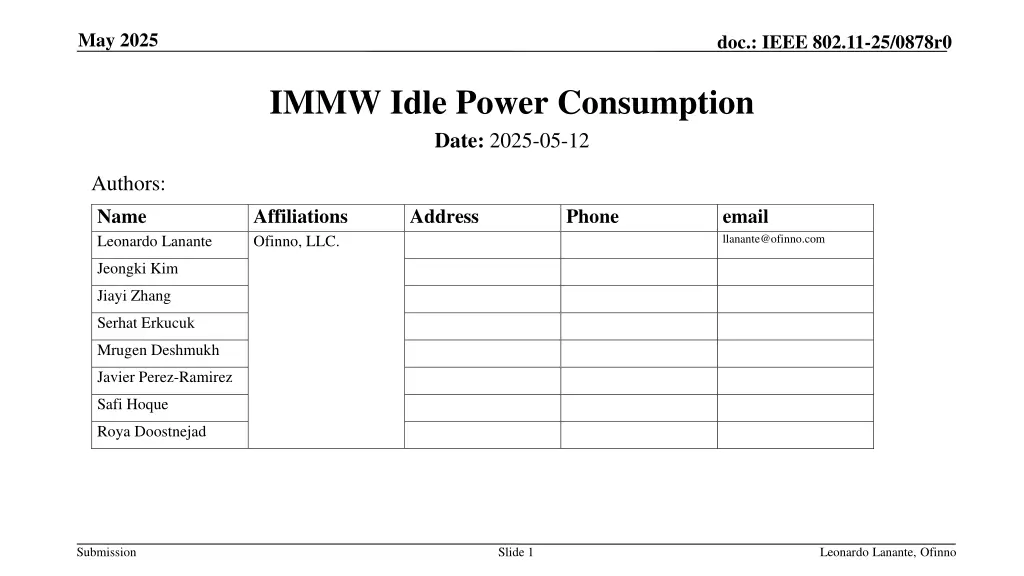
Reducing Idle Power Consumption in mmWave Links
Exploring methods to decrease idle power consumption in mmWave links to address the challenges posed by higher frequency ADCs, beam training, and device characteristics. Topics include leveraging listening mode and dynamic power save mechanisms, minimum bandwidth requirements for IMMW STAs, and possible approaches like ICF transmission at different MHz bands.
Download Presentation

Please find below an Image/Link to download the presentation.
The content on the website is provided AS IS for your information and personal use only. It may not be sold, licensed, or shared on other websites without obtaining consent from the author. If you encounter any issues during the download, it is possible that the publisher has removed the file from their server.
You are allowed to download the files provided on this website for personal or commercial use, subject to the condition that they are used lawfully. All files are the property of their respective owners.
The content on the website is provided AS IS for your information and personal use only. It may not be sold, licensed, or shared on other websites without obtaining consent from the author.
E N D
Presentation Transcript
May 2025 doc.: IEEE 802.11-25/0878r0 IMMW Idle Power Consumption Date: 2025-05-12 Authors: Name Leonardo Lanante Affiliations Ofinno, LLC. Address Phone email llanante@ofinno.com Jeongki Kim Jiayi Zhang Serhat Erkucuk Mrugen Deshmukh Javier Perez-Ramirez Safi Hoque Roya Doostnejad Submission Slide 1 Leonardo Lanante, Ofinno
May 2025 doc.: IEEE 802.11-25/0878r0 Abstract TGbn leverages multi-link operation and existing sub-7GHz MAC/PHY to provide non-standalone operation in 42~71 GHz band. mmWave links are expected to have significantly higher idle power consumption due to higher frequency ADCs, beam training, and inherent characteristics of the mmWave devices. In this contribution, we discuss options to reduce the idle power consumption of mmWave links. Submission Slide 2 Leonardo Lanante, Ofinno
May 2025 doc.: IEEE 802.11-25/0878r0 Idle Power consumption As in [1], listening mode may contribute more than half of the power consumption of a modern device. This is the time when the device is awake but not transmitting or receiving. For IMMW, a mmWave STA may need to be in listening mode when waiting to receive a frame from an AP (e.g. Beam training frames, DL Data/control frames, etc.) To allow the mmWave STA to conserve its power while listening, we can leverage the ICF/ICR exchange in 11bn. Submission Slide 3 Leonardo Lanante, Ofinno
May 2025 doc.: IEEE 802.11-25/0878r0 Dynamic Power Save in 11bn The DPS operation allows a DPS STA to operate in a lower capability (LC) mode and to transition to higher capability (HC) mode upon reception of an ICF transmitted by its AP. The DPS STA in higher capability (HC) mode transitions back to the LC mode after communication with the AP. SIFS ICF F C S pad AP Higher capability state ICR Lower capability mode DPS STA Transition delay Submission Slide 4 Leonardo Lanante, Ofinno
May 2025 doc.: IEEE 802.11-25/0878r0 Minimum Bandwidth for IMMW STAs In [2-3], minimum bandwidths of 80 MHz and 160 MHz were considered. Since decoding ICF frames is required for DPS, it means that a mmWave STA is required to be always ready to receive an 80 MHz or 160 MHz control frame. This may result in an idle power consumption in mmWave to be much higher compared to sub-7GHz STA in lower capability mode. - ADCs for 20 MHz vs 160 MHz can have about 8x more power consumption. Submission Slide 5 Leonardo Lanante, Ofinno
May 2025 doc.: IEEE 802.11-25/0878r0 Possible Approaches 1. ICF transmit/receive similar to 11bn but done at 80/160 MHz. High idle power consumption but design is simple. 20 MHz RSSI based listening (no decoding) Option 1 ICF is transmitted using 80/160 MHz. Option 2 ICF is transmitted using 20 MHz. Possible false alarms due to interference. Low idle power consumption. 3. Cross-link ICF In this method, the ICF for the mmWave link is transmitted in a sub-7GHz link Disadvantage: potential congestion problems in the sub-7GHz link. 2. Submission Slide 6 Leonardo Lanante, Ofinno
May 2025 doc.: IEEE 802.11-25/0878r0 Conclusion We discussed the need for reducing the idle power consumption for IMMW STAs. Due to the much higher base bandwidth, listening operation by mmWave STAs may be much higher any may result in faster battery drain of IMMW enabled devices. We proposed several approaches to reduce the idle power consumption. Submission Slide 7 Leonardo Lanante, Ofinno
May 2025 doc.: IEEE 802.11-25/0878r0 References [1] https://mentor.ieee.org/802.11/dcn/22/11-22-1414-01-0uhr-low-power- listening-mode.pptx [2] https://mentor.ieee.org/802.11/dcn/25/11-25-0854-00-00bq-considerations- on-numerology-for-immw.pptx [3] https://mentor.ieee.org/802.11/dcn/25/11-25-0360-00-00bq-high-level- thoughts-on-immw-phy-design.pptx [4] https://mentor.ieee.org/802.11/dcn/24/11-24-0471-00-immw-considerations- on-power-consumption.pptx Submission Slide 8 Leonardo Lanante, Ofinno
May 2025 doc.: IEEE 802.11-25/0878r0 SP Do you agree that power consumption of mmWave STAs during listening should be made similar to sub-7ghz STAs. Submission Slide 9 Leonardo Lanante, Ofinno

